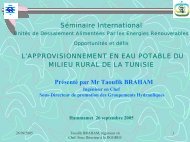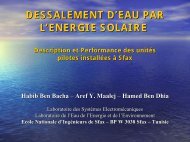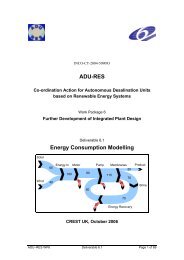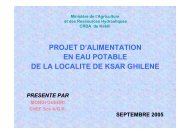- Page 1 and 2: Co-ordination Action for Autonomous
- Page 3 and 4: TABLE OF CONTENTS TABLE OF CONTENTS
- Page 5 and 6: during the past decade there has be
- Page 7 and 8: 1. INTRODUCTION The need of water i
- Page 9 and 10: Researchers are still in the proces
- Page 11 and 12: Figure 3 presents the progress of s
- Page 13 and 14: example is found in Lampedusa islan
- Page 15 and 16: (blades, etc.), plus installing two
- Page 17 and 18: 3. GENERAL GUIDELINES FOR TECHNOLOG
- Page 19 and 20: Among the technologies selection an
- Page 21 and 22: system has only cartridge filters f
- Page 23 and 24: Fig 8 Block diagram of the Wind RO
- Page 25 and 26: • No available supply of water on
- Page 27 and 28: Pic. 3 The battery storage system o
- Page 29 and 30: • in order to avoid the reduction
- Page 31 and 32: on a constant basis and managing th
- Page 33 and 34: c. Experiences and Lessons learnt -
- Page 35 and 36: electricity for fishing conservatio
- Page 37 and 38: Fig 10 Diagram of the control syste
- Page 39 and 40: plant and equipment facilities, the
- Page 41 and 42: 4.2 WIND ENERGY DRIVEN VAPOUR COMPR
- Page 43 and 44: isolation transformer located in a
- Page 45 and 46: c. Experiences and Lessons Learnt O
- Page 47 and 48: 4.3 PHOTOVOLTAIC DRIVEN REVERSE OSM
- Page 49: PV system (64 modules) and a 19 kWh
- Page 53 and 54: Table 9 Costs of the PV-RO plant Eq
- Page 55 and 56: . System Description The photovolta
- Page 57 and 58: 4.3.5 Autonomous PV Water Pumping-R
- Page 59 and 60: efficiency of the inverter for vari
- Page 61 and 62: c. Experiences and Lessons Learnt T
- Page 63 and 64: 4.4 SOLAR THERMAL SYSTEM DRIVEN MUL
- Page 65 and 66: The most outstanding solar ME syste
- Page 67 and 68: (considering 50% solar contribution
- Page 69 and 70: - The condensation process should b
- Page 71 and 72: Sfax a. Introduction A solar multip
- Page 73 and 74: 4.4.3 SODESA Project, Gran Canaria
- Page 75 and 76: Fig 24 Block diagram of the pilot p
- Page 77 and 78: The pilot MED plant is designed to
- Page 79 and 80: mirror concentrators are tracking t
- Page 81 and 82: each component of the pilot plant.
- Page 83 and 84: that the performance of the pilot p
- Page 85 and 86: 4.5 HYBRID POWER SUPPLY PLANT DRIVE
- Page 87 and 88: - pyranometer to measure the solar
- Page 89 and 90: PV Generators 3.9 kW, SM110 ……
- Page 91 and 92: the replacement of the carbon and t
- Page 93 and 94: d. Cost Data The unit water cost wa
- Page 95 and 96: The battery bank than serving provi
- Page 97 and 98: continuously to find and compare th
- Page 99 and 100: 5. CONCLUSIONS & RECOMMENDATIONS Ke
- Page 101 and 102:
6. DESALINATION RES PROJECTS The su
- Page 103 and 104:
Title Programme (EEC) of financial
- Page 105 and 106:
Title Regulation (EEC) establishing
- Page 107 and 108:
6.1.1. Research / Cost sharing proj
- Page 109 and 110:
Title Year Table 14 PV-powered proj
- Page 111 and 112:
time. The 4 operating years of the
- Page 113 and 114:
Note: As the projects were implemen
- Page 115 and 116:
such stand-alone systems are of gre
- Page 117 and 118:
The following projects (AQUASOL and
- Page 119 and 120:
technology (AQUASOL) technology bas
- Page 121 and 122:
A main point for developing the new
- Page 123 and 124:
Specific capital costs, €/m3 35 3
- Page 125 and 126:
- Solar thermal seawater desalinati
- Page 127 and 128:
The anticipated overall cost reduct
- Page 129 and 130:
The project tasks comprised: - Modi
- Page 131 and 132:
• The development of the collecto
- Page 133 and 134:
prevailing at the test site, the co
- Page 135 and 136:
transfer fluid. The concept of DEAH
- Page 137 and 138:
2005, to be started up in January 2
- Page 139 and 140:
• Development and testing of the
- Page 141 and 142:
Table 19 Wind energy desalination p
- Page 143 and 144:
implementation scheme for decentral
- Page 145 and 146:
Optionally an energy storage system
- Page 147 and 148:
Pic. 42 View on RO unit on Syros Pi
- Page 149 and 150:
unit and membranes are taken into c
- Page 151 and 152:
eached the level of technology, whi
- Page 153 and 154:
Short description of the project Th
- Page 155 and 156:
Table 22 Approximate costs for a ty
- Page 157 and 158:
• The cost of drilling and testin
- Page 159 and 160:
1. Collection of climatic data, i.e
- Page 161 and 162:
The RO plant designed for this proj
- Page 163 and 164:
- Generating information on market
- Page 165 and 166:
Turkey Water source: Ground & Surfa
- Page 167 and 168:
The project team focuses on the des
- Page 169 and 170:
9. Preparation of the installation,
- Page 171 and 172:
and water needs of the Mersini vill
- Page 173 and 174:
France 22% Greece 22% Germany 11% S
- Page 175 and 176:
Title Year Multi-stage-flash desali
- Page 177 and 178:
Characteristics of the solar fields
- Page 179 and 180:
vacuum pump is required upon start-
- Page 181 and 182:
salts whose concentration approache
- Page 183 and 184:
The operation tests took place at t
- Page 185 and 186:
It could be concluded that PV based
- Page 187 and 188:
well as to compare DC motor pumps w
- Page 189 and 190:
Project title Almeria solar powered
- Page 191 and 192:
Project title PV powered lighthouse
- Page 193 and 194:
Innovative aspects and conclusions
- Page 195 and 196:
Applications include domestic light
- Page 197 and 198:
A 32 kWp PV system with 500 Ah/220
- Page 199 and 200:
Menorca Wind generator based electr
- Page 201 and 202:
Design, manufacturing and installat
- Page 203 and 204:
Up to date the wind turbine has bee
- Page 205 and 206:
Nicolas, in West France, with wind
- Page 207 and 208:
connected to the grid (for back-up)
- Page 209 and 210:
daytime as intermediate or peak loa
- Page 211 and 212:
N o Acronym Title CODEC CPC collect
- Page 213 and 214:
N o Acronym Title SODESA AQUASOL ME
- Page 215 and 216:
N o Acronym Title REDDES Wind power
- Page 217 and 218:
SDAWES Seawater desalination plants
- Page 219 and 220:
No Title Year Lipari island water d
- Page 221 and 222:
No Title Year 1.2 MW wind turbine i
- Page 223 and 224:
6.1.3 Conclusions Solar thermal: Th
- Page 225 and 226:
Membrane desalination Hybridized Sy
- Page 227 and 228:
No Title Year PV powered desalinati
- Page 229 and 230:
Project title PV powered desalinati
- Page 231 and 232:
⇒ A promising battery-less system
- Page 233 and 234:
-- strong mismatch +/- very diverse
- Page 235 and 236:
technological advancements with a s
- Page 237 and 238:
Sea water potable solar � PV-ED p
- Page 239 and 240:
• the necessity for mobility of a
- Page 241 and 242:
to drive the desalination unit and
- Page 243 and 244:
The evaporation paper reduces the v
- Page 245 and 246:
thermal seawater desalination syste
- Page 247 and 248:
⇒ The model parameters for the ot
- Page 249 and 250:
electrical power was supplied by PV
- Page 251 and 252:
6.3. Other projects There are many
- Page 253 and 254:
Technical Description It is a horiz
- Page 255 and 256:
Short description of the project Th
- Page 257 and 258:
Project title Project acronym PUNTA
- Page 259 and 260:
7. DESALINATION RES MODELS In recen
- Page 261 and 262:
user provides as input data: the am
- Page 263 and 264:
RES Desalination Models ID Number 1
- Page 265 and 266:
ID Number 2 Name of Programme Middl
- Page 267 and 268:
Fig. 1, 2 Start up screen and RES p
- Page 269 and 270:
The main input parameters for the D
- Page 271 and 272:
ID Number 6 Name of Programme ALTEN
- Page 273 and 274:
ID Number 7 Name of Programme APAS
- Page 275 and 276:
wind and PV power) and conventional
- Page 277 and 278:
References G. Ambrosone, et al, “
- Page 279 and 280:
Sources for Water Production, 10-12
- Page 281 and 282:
APPENDIX 278
- Page 283 and 284:
Plant Type & Information Source Sea
- Page 285 and 286:
Capacity 22 m 3 /day Desalination T
- Page 287 and 288:
Manufacturing Company/Responsible O
- Page 289 and 290:
Desalination Technology Multi-Effec
- Page 291 and 292:
Manufacturing Company/Responsible O
- Page 293 and 294:
Energy System Type Year Commissione
- Page 295 and 296:
Manufacturing Company/Responsible O
- Page 297 and 298:
Plant Type & Information Source Loc
- Page 299 and 300:
Plant Type & Information Source Loc
- Page 301 and 302:
Manufacturing Company/Responsible O
- Page 303 and 304:
Desalination Technology Energy Syst
- Page 305 and 306:
RES Hybrid - Desalination Applicati
- Page 307 and 308:
A2. OTHER RES - DESALINATION TECHNO
- Page 309 and 310:
- efficient and compact spiral-woun
- Page 311 and 312:
• membrane area 6 m² - 12m² •
- Page 313 and 314:
pressure loss of the 7m² collector
- Page 315 and 316:
enough insulation is available the
- Page 317 and 318:
operation period between 10:00am Ma
- Page 319 and 320:
BIBLIOGRAPHY [1] E. Obermayr, K. Sc
- Page 321 and 322:
[24] M. Abu-Jabal et al, “Providi
- Page 323 and 324:
[54] Paulo Cesar Marques de Carvalh







